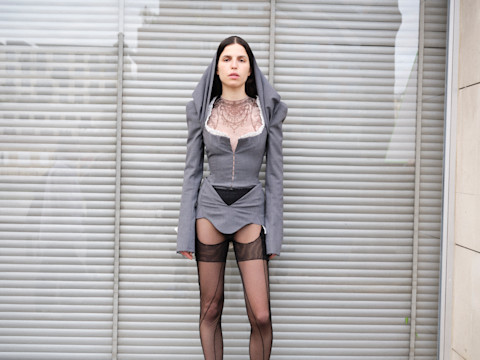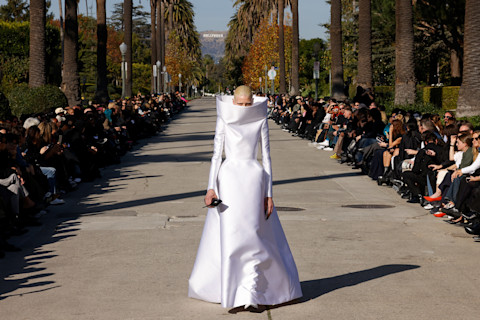The Making of a Modern Fashion Critic
Inside the opulent world of Rachel Tashjian, the star writer courting influence between her classic newspaper column and her IYKYK newsletter.
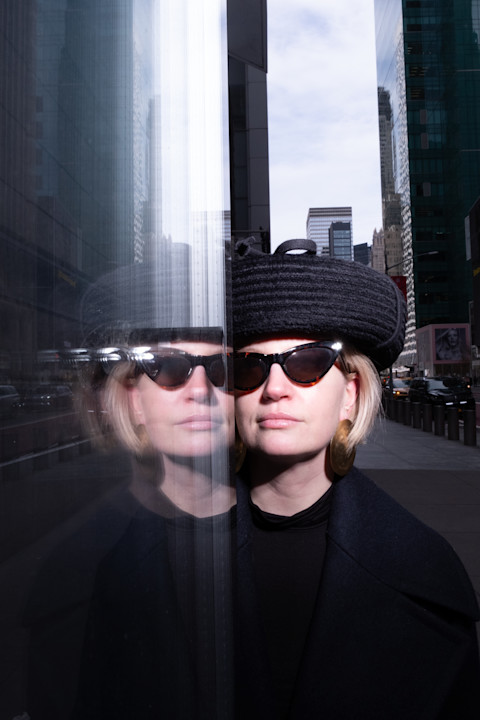
When we met up for lunch shortly after Valentine’s Day, my first question for Rachel Tashjian was where she got her outfit. We were at a French restaurant in Midtown, near her apartment. Tashjian was happy to oblige, clothes being her business as fashion critic at the Washington Post: her shirt and jacket were vintage Romeo Gigli. She bought the pieces off Etsy, from a woman who was raised Amish. “She moved to Chicago, and fashion became this huge way for her to rebel against her Amish upbringing,” Tashjian said. “Isn’t that amazing?” She had learned all of this from a note that the woman had sent her.
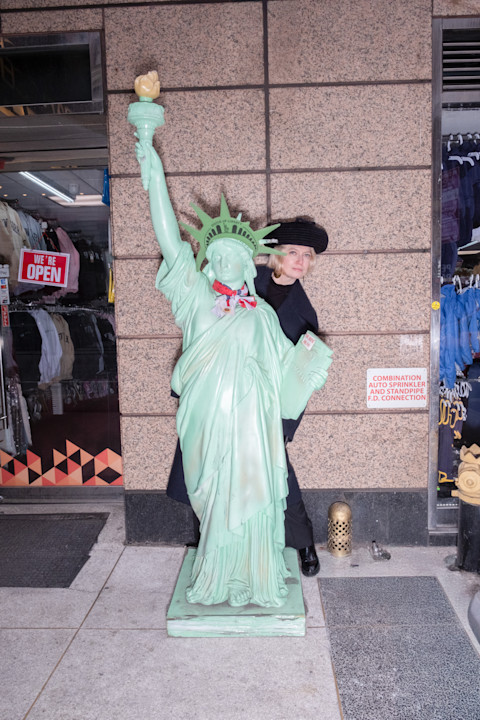
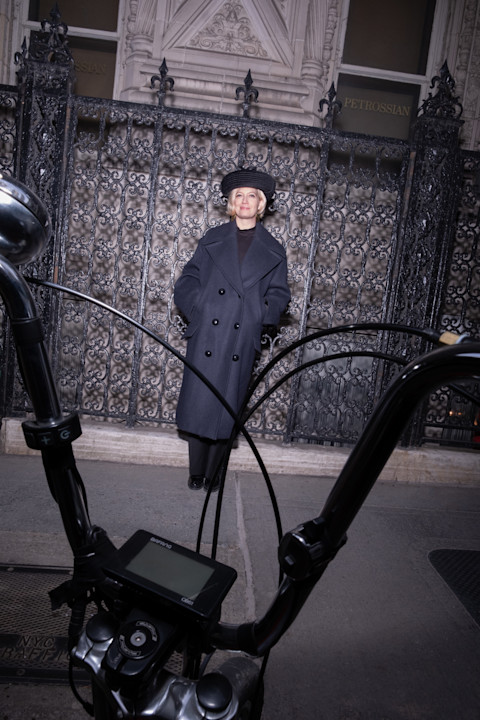
This is, I’d learn, a quintessential Tashjian anecdote: a yarn about a woman exerting her fabulous and intriguing personhood through equally sensational clothing. In Tashjian’s world, shopping is evidence of living—of a certain worthy hunger for pleasure and beauty—and clothing should never be divorced from the people who end up wearing it. She finds it odd when people feel the need to justify the importance of fashion by situating it as art, or when they only seem to care about garments as they appear on the runway or in magazine editorials. “How is the runway image of a dress the most interesting thing about it?” she asked. “Isn’t it much more interesting when you turn a corner and, , see someone wearing that?”As a former staffer at , , and , Tashjian built a reputation as a must-read fashion writer, profiling designers like Miuccia Prada, Donatella Versace, and Simone Rocha. Since joining the in 2023, she has, at 36, cemented her status as one of the most exciting and influential fashion critics working today, putting her in company with newspaper veterans like Robin Givhan, Vanessa Friedman, and Cathy Horyn. Like any millennial writer, she broadcasts across multiple platforms. Her invitation-only shopping newsletter, “Opulent Tips,” is a showcase for her one-of-one personal style and an opportunity to act as an enabling aunt who introduces readers to such earthly delights as vintage crochet gloves, Elsa Peretti–designed candlesnuffers, and brandy-soaked clementines. For the most part it arrives weekly, with gaps for fashion month, vacation, and, in Tashjian’s words, “unavailability of the nine muses.”Tashjian hoovers up cultural morsels with the efficiency of a next-generation Dyson: “She loves to tear through a book, put it down, and open up the next one,” her husband, executive editor Lloyd Wise, told me. This omnivorous appetite has served her well at the , where her job is to put fashion in its cultural context for a wide readership. Her survey of this year’s Oscars red carpet, for instance, examined the crushing perfectionism encouraged by Ozempic and AI. “Women must now look too perfect. They are shrinking before our eyes, seeming to age backward,” Tashjian wrote. “None of this is natural, or looks natural, or feels natural. And while in some ways we have moved on from snap judgments about actresses’ appearances, mostly we seem to have no language to discuss what’s happening.”
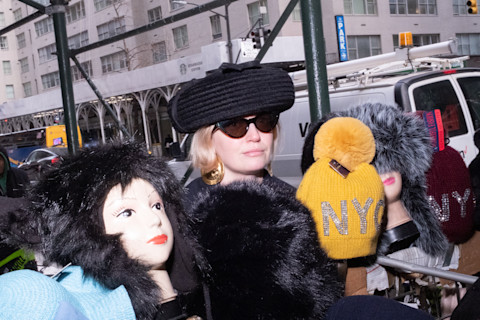
In many of her columns, there is a line so truthful that it arrests you for a moment—we know how to talk about Ozempic’s noticeable influence on Hollywood, I thought to myself, a little annoyed that the idea hadn’t crossed my mind while watching the Oscars red carpet. The way screenshots of Tashjian’s writing float around Instagram the day after she publishes an article, it’s clear that her language provides clarity and affirmation to many of her readers.“Obviously she’s first and foremost a fashion writer and fashion critic, but I really think of her as a cultural critic as well, because she’s quite knowledgeable about a wide swath of contemporary and historical culture,” says Ben Williams, an editor who worked with her at the and , citing her facility with the history of everything from legacy magazines and Hollywood to New York socialites and rock and roll. (In an email, the designer Tory Burch added these items to the list of Tashjian’s fascinations: classic films, chamber music, Bunny Mellon, and traditional French cooking.)Whereas bad criticism can be opaque and academic to the point of making the reader feel like a moron, Tashjian’s writing is inviting, conspiratorial, and full of buoyant one-liners that make you wonder if the author isn’t partially writing for her own amusement (“There was a row at The Row over the front row!”). It’s fun to read, and you feel smarter when you’re finished. Tashjian is so evidently enthusiastic about fashion and culture that she can get away with, for instance, bestowing the title of “The Rowdents” to the many labels imitating the style of The Row. I doubt that she’s trying to get blacklisted by any designers, but from the way she told me about a show invite going missing after a less-than-glowing review, the idea clearly didn’t intimidate her, either.“I think a lot of people, right now, are afraid to have an opinion. There’s something really scary about it, because of how much feedback we all get on even the smallest opinions,” says Lindsey Underwood, Tashjian’s editor at the “It’s easier to ride the middle, and I think Rachel has a clear perspective and is able to express that without at least showing any kind of apprehension about how someone will receive her opinion.”And many fashion professionals want to hear Tashjian’s critiques. Burch, whom Tashjian has profiled and reviewed, told me that she’s a regular reader: “I’m always curious to hear Rachel’s point of view, I absolutely listen and take to heart all that she has to say.” Stylist Danielle Goldberg, who works with actors like Ayo Edebiri and Greta Lee, said that she always finds herself in agreement with Tashjian’s columns, which boosts her professional confidence. “It just makes me more secure, leaning into my own intuition,” she said.Tashjian’s own style is a matter of fascination for some designers, too. The day after our lunch in Midtown, I met with the creative director of a popular clothing brand at the company’s offices in Soho. While we chatted, I mentioned that I’d interviewed Tashjian the day before. The creative director’s eyes lit up. What was she wearing? I told him about the Romeo Gigli outfit, how, as I remembered it, the sleeve cuffs were bands of crimson and mustard fabric dotted with luminous mother-of-pearl buttons. The creative director nodded along, pleased by the answer.
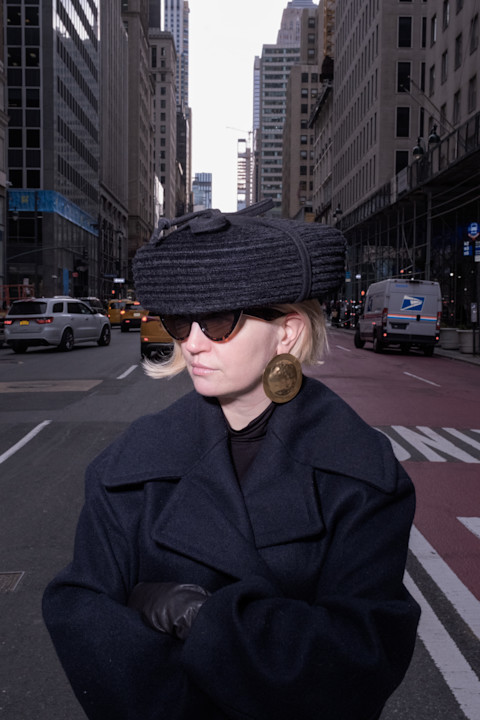
When it comes time to write “Opulent Tips,” Tashjian loosens her necktie and cranks up the volume. In each edition of the newsletter, she riffs on her latest obsessions—often in joyful bursts of all caps—and offers shopping advice to readers in search of pajama sets, personalized stationery, and, in one case, magician-adjacent formalwear. There is no -like objectivity to this shopping column; far from methodical and dutiful, it’s heartfelt and unruly. You come to “Opulent Tips” to see what incredible vintage items Tashjian has uncovered on Etsy, and to learn about 1970s interior design and Max Vadukul’s old photos for Yohji Yamamoto.Reading the newsletter is its own kind of opulence. “When it comes in, I want to be reclined, and I want a warm beverage in my hand. If there were a fire, that would be great, as well,” said the film director Janicza Bravo, a subscriber and frequent flyer on the newsletter’s annual best-dressed list. She was recently captivated by Tashjian’s suggestion to hang a little basket on your doorknob and fill it with lavender when guests come over. “It’s an exercise in taking pleasure in the small objects,” Bravo said.Tashjian first launched “Opulent Tips” in the mid-2010s, then shuttered it for a while before revving it back up in 2020. Unlike many of the shopping newsletters that would follow, it is completely free—with the caveat that you can only get on the list by emailing Tashjian directly. It has just under 3,000 subscribers, including writer and filmmaker Miranda July, playwright Jeremy O. Harris, celebrity stylists Kate Young and Danielle Goldberg, actress Jodie Turner-Smith, and Lorde, the singer. “There’s something a little scandalous about having a newsletter that’s called ‘Opulent Tips,’ but then it’s free, but then it’s gatekept—but not gatekept ,” said July.Tashjian said that she would be happy to have more subscribers, but she has made the process “idiotically laborious” for herself. She sends “Opulent Tips” by regular old email, requiring her to employ several different accounts because Gmail cuts each one off at 500 emails per day.“Still, I have resigned myself to operating this newsletter like a charming country inn with no online reservation system,” she would later explain to me in an email. “If people really want to stay there, they’ll figure out how to get in touch with the innkeeper!!”

Despite Tashjian’s laser-like ability to read this cultural moment, her tastes suggest that she’s not quite of our time. It’s the way she eats soft-boiled eggs for breakfast out of gleaming egg cups. How, when she got married in the fall of 2022, she modeled her “enormous” hairstyle off a photo of Deeda Blair, the nonagenarian philanthropist and social fixture known for her helmet-like coiffure. It’s her penchant for topping off an outfit, often vintage, with an interesting hat. Not a baseball cap or a beanie—an honest-to-God hat, technical descriptions of which I can’t even muster (there’s one that looks a bit like a plush doughnut?) because almost nobody wears real hats these days, except for Tashjian.I’ve felt a little silly thinking of her as a kind of time traveler. Tashjian edited me a few times when she was at , and nothing about that experience suggested she was anything less than a native user of Google Docs. But when I called up her husband, he said something similar, completely unprovoked.Tashjian and Wise met at a party in 2016, although it would be a couple years before they began dating, and in one of their first conversations, Tashjian told Wise about her membership to the Colony Club, a private women’s-only club located on Park Avenue. “It’s already quite an antiquated sort of institution, and she spoke about it in a way that just felt like an old movie—like speaking with a movie star from an old movie,” said Wise. “I remember running into her again a few weeks later and I asked her something about the Colony Club. There must have been something in the tone of my voice because she said, ‘Lloyd, are you me?’ It was like dialogue from a Preston Sturges film.”For her part, Tashjian explained that while her family always liked vintage things, this interest truly blossomed when she started dating Wise, with whom she shares a fascination with old clothes, art, and furniture. But, she noted, they worship the past while committing themselves to the future—to progress and modernism.True enough, Tashjian’s career as a fashion writer started at what was then the forefront of millennial culture: with a blog. Growing up in Wilmington, Delaware—an old-school, preppy city known for its ties to the du Pont family—she loved playing around with clothes and came from a family of great shoppers. (Her father, she told me, can go into “the worst store and find something beautiful.”) She attended boarding school in New Jersey as a teenager, and for their twice-weekly formal dinners, she would pull out her more offbeat outfits, including a white pinafore with big ruffled shoulders that was a human-scale version of a dress worn by Molly McIntire, the American Girl Doll. But designer fashion, as presented in magazines, felt distant and unattainable. “I felt like, I’m never going to be in a world where I’m buying a $3,000 handbag,” she said.
In college at the University of Pennsylvania, Tashjian began dropping by a local boutique called Joan Shepp, where she’d ask the manager about different brands, building out her knowledge bit by bit. Dries Van Noten was the first designer that really captured her attention: “It felt a little vintage, but it was accessible. Pragmatic, in a way.” This was also around the time that fashion bloggers were beginning to gain real traction, and as Tashjian saw them interacting with designer clothing in real life, those items started feeling less remote. “Tavi [Gevinson] borrowing the Comme clothes and doing a photo shoot in her backyard—I was like, oh wait, this is really cool. You’re supposed to have these clothes in your life,” she said.Tashjian started her own Tumblr fashion blog in 2011, shortly after graduating from college. It was called “Pizza Rulez.” (No, it doesn’t exist anymore. But yes: It is the root of her Instagram handle, @theprophetpizza.) Tashjian posted her own outfits, but she also poked fun at fashion blogging, which had begun to transform into influencing. “I would use it to experiment and try different kinds of writing,” she said. “Not that many people were reading it, which was sort of nice . . . I would publish a post and look at my Google Analytics, and it was one person reading. Like, ooh, I wonder who it is!”The tone of “Pizza Rulez,” she said, was similar to “Opulent Tips.” The blog caught the eye of John Jannuzzi, an editor at the now-defunct Condé Nast magazine . He was tasked with building relationships with up-and-coming style bloggers and, impressed with Tashjian’s unique sense of humor, immediately brought her into the magazine’s creator network. (In one satirical post, Jannuzzi told me, Tashjian announced that she was the new spokesperson for “jackets.”) Freelance work writing for the irreverent menswear site followed. At the time, Tashjian was employed at a consulting firm, doing communications, marketing, and public relations. Then, one day, a recruiter at Condé Nast messaged her about a position in ’s in-house PR department.“That was honestly better than going to journalism school,” said Tashjian. Her job was to reach out to journalists at other publications to share ’s latest reporting, and several times a day, she found herself in her boss’s office, talking about stories. In the process, she learned not only how to promote articles, but how to report and structure them. In 2017, Tashjian landed her first full-time writing gig, at magazine. Next was , where she found her groove writing in a fast, spirited way. (Will Welch, ’s global editorial director and US editor-in-chief, compared Tashjian’s writing to the adrenaline-filled atmosphere at a stock car race: “Hang on for dear life and let it take you on a ride.”) Then came , where she worked under editor-in-chief Samira Nasr, whom Tashjian regards, admiringly, as someone with a much deeper knowledge of luxury fashion than her.Tashjian may have more to learn from her mentors, but the curiosity that drove her to interrogate the manager at Joan Shepp has nonetheless gelled into a formidable handle on fashion history. She may spend weeks and months percolating on a topic—talking to colleagues, visiting a brand’s store to try on the clothes herself—but when she sits down to write, she hammers out copy with remarkable velocity and confidence. “She just locks in. Nothing can distract her,” said Wise. If he addresses her while she’s in the zone, his words ricochet off her psychic forcefield, unheard.As Welch told me, Tashjian instinctively grasps—and has clarified for him—the way that media works now. It used to be that a writer would toil away in the blogging salt mines so that, one day, they would have the seniority to write fewer, more ambitious, more deeply reported stories. For Welch, Tashjian exemplifies the “new math” of developing an audience and becoming a renowned writer. “If you want to be the one that everyone’s talking about, you’ve got to have bylines,” he said. “You’ve got to be publishing a lot.”


When Tashjian worked at , a magazine then owned by Vice Media, she had colleagues who had come from and would say that they worked in the fashion industry. This shocked her. “I was like, no, we work in the industry!” she said, her voice scandalized. As we were wrapping up lunch and preparing to take Tashjian’s dachshund, Ritz, for a stroll in Central Park, I asked whether she feels like she’s a member of the fashion establishment now. “I don’t feel like I’m really part of it at all,” she said. “I don’t want to be friends with designers. I have, I would say, very few friends in the fashion industry—like genuine friends.”Tashjian told me that when she’s writing, she only has her readers in mind; what a designer might think of her criticism doesn’t usually come into play. She has read a great deal of fashion writing, past and present, and while she sees a critic like Horyn as someone with a talent for writing as though directly to a designer, Tashjian has found a different focus for herself. If she has an agenda with both “Opulent Tips” and her writing for the , it’s to help people shop better. “It’s become really hard to be a knowledgeable and sophisticated consumer,” she said, citing declining product quality and online shopping. Her goal isn’t to push people to buy the best porcelain, she told me, but rather to encourage people to ask more of themselves and more of designers.To learn that Tashjian is so thoroughly on her readers’ team is, perhaps, a bit surprising, even though it’s right there at the top of every “Opulent Tips” email: Any person who asks Tashjian a question automatically earns the title of “Reader and Friend to Me (RAFTM).” But the fact is, fashion critics are intimidating. If they’re unafraid to issue negative reviews of professional designers’ work, what must they think of you and your old winter coat? It’s comforting to know, then, that while Tashjian is looking at what you’re wearing, it’s in a much warmer light than you might imagine. Burch told me that the thing she likes most about Tashjian is that she’s “completely unpretentious.”Real curiosity, real open-mindedness, are rare qualities. After lunch, Tashjian and I collected Ritz from her apartment, which was filled with the cozy scent of the lamb shanks Wise was making for dinner, and set off toward the park in the slanting afternoon sunlight. As we tramped across the snow, letting brave Ritz navigate ahead, we talked about Miuccia Prada, whom Tashjian had profiled several years ago.“She would say, ‘I’m going to say something, and I don’t know if it’s true. I don’t know if I really think this,’” Tashjian said. “I think that’s really cool, to allow your mind to be that open, even if your new idea is wrong.”Prada asks lots of questions, and she likes to debate and argue—not just about fashion, but about women, power, and the state of the world. During their conversations, Tashjian found her own statements being interrogated by the designer, in an odd reversal of the usual interview script. She related this with excitement, as though the experience had left her invigorated, her tools freshly sharpened.
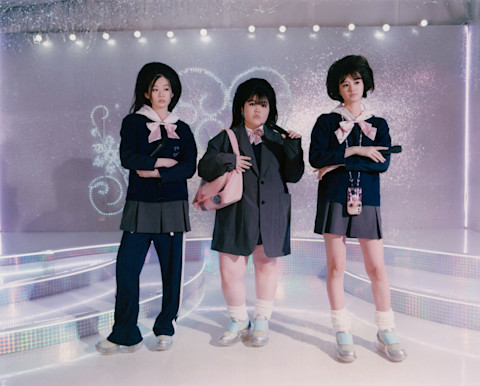 FAN GIRL Universe Meets Petra Collins and Jenny Fax Is anything quite so sacred to girlhood as the bedroom? For Petra Collins, girlhood was a period of discovery, a time when art was an escape and a roadmap for the future. Her bedroom was a shrine to her dreams and ambitions, filled with photographs, posters, and collected ephemera. Years later, she still builds on that eternal girlhood, translating it into images, films, and her fashion brand, I’m Sorry by Petra Collins .
FAN GIRL Universe Meets Petra Collins and Jenny Fax Is anything quite so sacred to girlhood as the bedroom? For Petra Collins, girlhood was a period of discovery, a time when art was an escape and a roadmap for the future. Her bedroom was a shrine to her dreams and ambitions, filled with photographs, posters, and collected ephemera. Years later, she still builds on that eternal girlhood, translating it into images, films, and her fashion brand, I’m Sorry by Petra Collins . 
